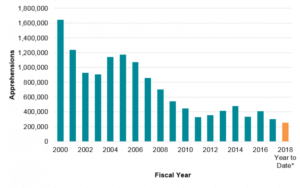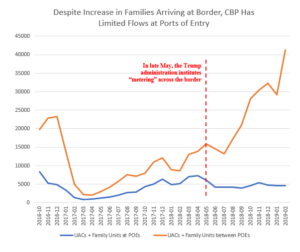If you listened to DHS officials and multiple reports in the last couple days, you might believe there is an unprecedented surge of migration at the southwest border. Reality, facts, and data show otherwise. While there is a steadily changing demographic of the population seeking to enter the United States, the overall numbers are still nowhere near the high we saw in 2000. Furthermore, the Border Patrol is seeing a steady increase in the number of people turning themselves in and seeking asylum, not people seeking to evade them. Instead of managing these steady changes in a responsible and efficient manner, this administration has distorted facts, instituted a policy that encourages people seeking protection to cross the border away from official checkpoints, failed to address root causes, and continues to close doors on long-standing U.S. refugee and asylum programs that could channel some of these flows of migration in a smart way.
Total Southwest Border Apprehensions Still at Historically Low Levels
According to U.S. Customs and Border Protection (CBP) figures, in 2000, and in 1986, the Border Patrol apprehended record numbers at the southwest border, more than 1.6 million people. Since 2000, those numbers have steadily decreased to a low of 304,000 in 2017, the lowest level in more than 40 years. In 2018, we saw a slight increase to 397,000. In the first five months of this fiscal year, total apprehensions are still low at 268,000.
Source: Migration Policy Institute
Changing Demographic: Families Turning Themselves In To Seek Protection From Violence and Poverty
According to the Migration Policy Institute (MPI), there is a shift in the demographic being apprehended by the Border Patrol. For decades it was young Mexican males seeking opportunity for a better life. We are now seeing less Mexican males and more “Central Americans fleeing a mixture of violence and poverty. Increasing numbers of families and unaccompanied children seek out Border Patrol agents so they can turn themselves in and apply for asylum. Overall, 40 percent of those apprehended in FY 2018 were families or unaccompanied children, compared to 10 percent six years earlier.”
Figure 1. Family and Unaccompanied Minor Share of Southwest Border Apprehensions, FY 2012-19*
Source: Migration Policy Institute
Trump Administration “Metering” Policy Encourages Asylum Seekers to Seek Protection in Between Border Checkpoints
Secretary Kirstjen Nielsen and Border Patrol Chief Provost have both made pleas for asylum seekers to seek protection at border checkpoints. At the same time, backlogs of asylum seekers are drastically growing as a result of “metering” that was started in the spring of 2018, the policy by which DHS is drastically limiting the number of people that may apply for asylum at border checkpoints. Just 40-100 per day are allowed to apply at the San Ysidro border checkpoint. This in spite of a finding by the DHS Inspector General that metering is having the effect of pushing people toward applying for asylum in between border checkpoints, exactly what the Secretary the the Chief claim they want to end. Indeed, Aaron Reichlin-Melnick of the American Immigration Council compiled DHS data and found that while DHS was limiting asylum flows at border checkpoints, families were increasing in between border checkpoints, exactly what the Secretary and Chief say they don’t want.
Source: Aaron Rechlin-Melnick of the American Immigration Council
Trump Administration Failures to Address Root Causes
Instead of tweeting threats to cut off an already decreasing amount of aid, and ending TPS programs that will only serve to exacerbate problems in sending countries and stimulate increased out-migration, the Trump Administration should support public safety and sustainable economic development efforts by governments and NGOs in Honduras, El Salvador and Guatemala. But the Trump administration has sought cuts to aid to Central America. As Reuters summarized, “In 2016, the United States provided some $131 million in aid to Guatemala, $98 million to Honduras, and $68 million to El Salvador, according to U.S. data. By next year, those sums were projected to fall to $69 million for Guatemala, $66 million for Honduras and $46 million for El Salvador – a reduction of almost 40 percent for the three nations.” Congress recently pushed back on the Trump administration cuts and appropriated $527.6 million to address root causes.
Trump Administration Closing Doors on Long-standing U.S. Refugee and Asylum Programs
The Trump administration has ended or thwarted processing and resettlement programs from within the region that would obviate the need to travel to the U.S.-Mexico border to seek safety. Within six months of his presidency, the Trump administration ended the Central American Minors (CAM) program that enabled young people with strong claims for refugee status to apply in their home countries rather than take the dangerous journey to the border in search of protection. Furthermore, efforts by the Obama administration in 2016 to work with the UNHCR (the UN High Commission for Refugees) to set up refugee reception and processing centers in the region have dried up under Trump, with just 525 refugees resettled in the U.S. from all of Latin America in fiscal year 2018.
Furthermore, the Trump administration is closing door after door to asylum and other long-standing programs for people seeking protection or opportunity for a better life. Last summer, the Trump administration strong-armed adjudicators and immigration judges tasked with deciding the fate of thousands of asylum seekers to deny virtually all cases involving women fleeing horrific abuse, kids and others running from ruthless gangs, and most others claiming fear of persecution, where the persecution is not directly caused by a government. In the fall, the administration attempted to prohibit asylum applications in between border checkpoints despite the fact that Congress specifically authorized these applications. In spite of horrific conditions reported in camps where asylum seekers wait, the Trump administration announced just before Christmas last year that it would begin returning asylum seekers to Mexico while they await adjudication, a process that could take months or years.
Ur Jaddou, Director of DHS Watch and former USCIS Chief Counsel, said: “There is no national emergency at the border. What we are experiencing is a steady change in the demographic of border crossers — families fleeing violence and turning themselves in. The response should not be hysteria over a national emergency with a deployment of the military at the border; it should be a humanitarian response. What it requires is a regional refugee approach and in the U.S., a smart management to marshall government resources to appropriately and humanely handle an increasing number of families applying for asylum, not a policy that sends them back to live under horrific conditions in camps in Mexico. What it also requires is a smart foreign policy and aid strategy that targets route causes, not threats and cuts in aid. What it requires is smart, efficient, and fair implementation of refugee and asylum programs, not assaults on long-standing programs for people seeking protection from persecution around the world.”




